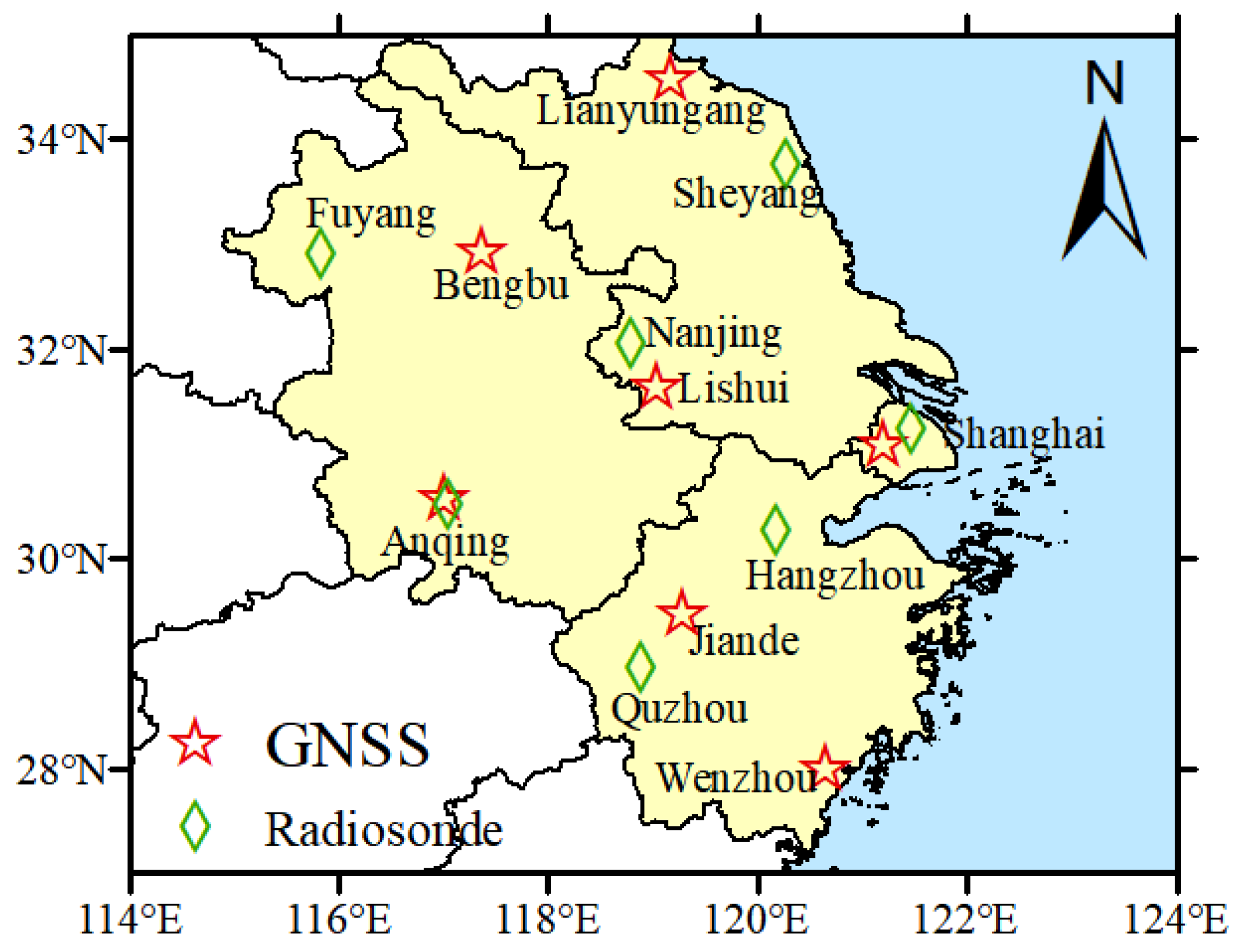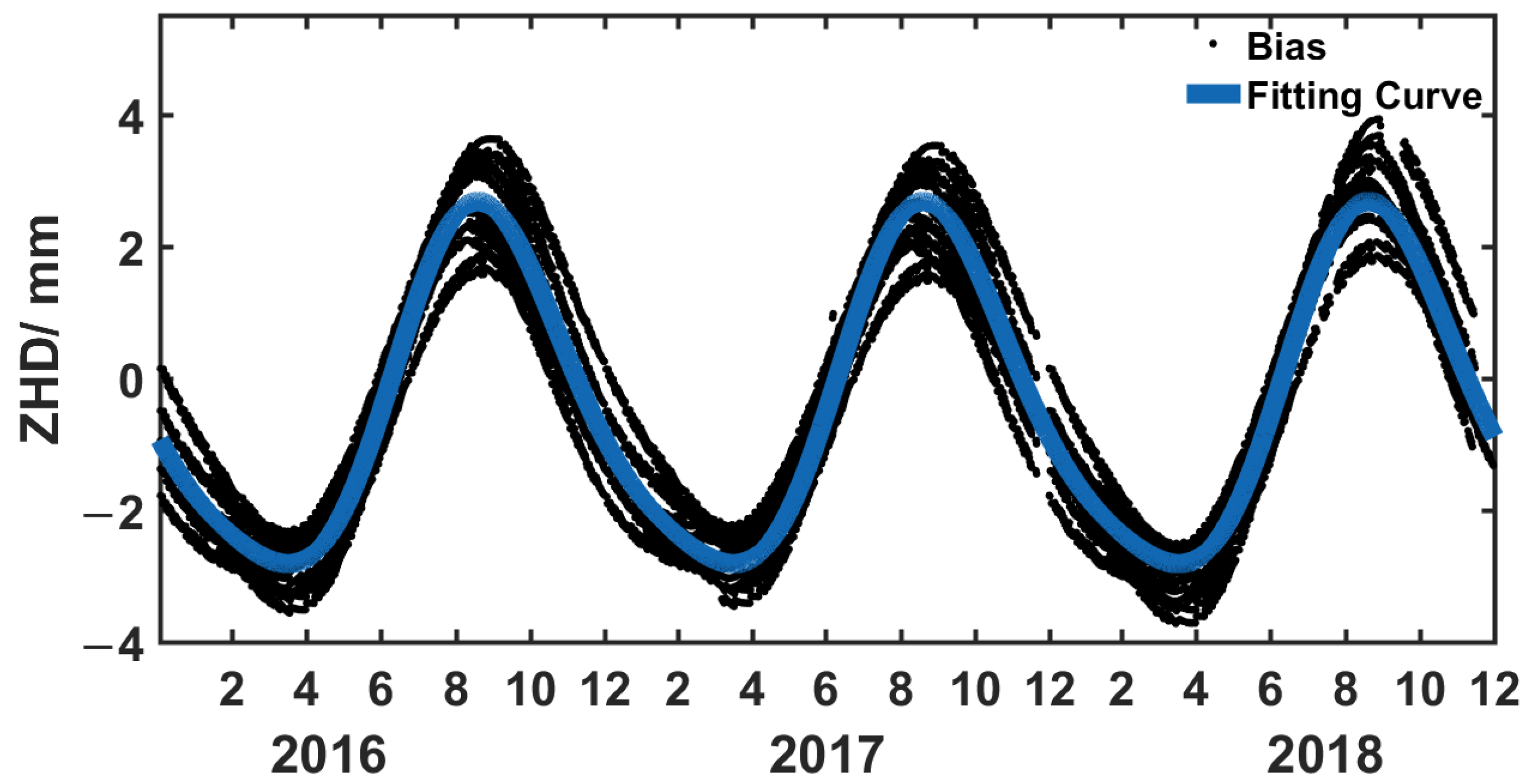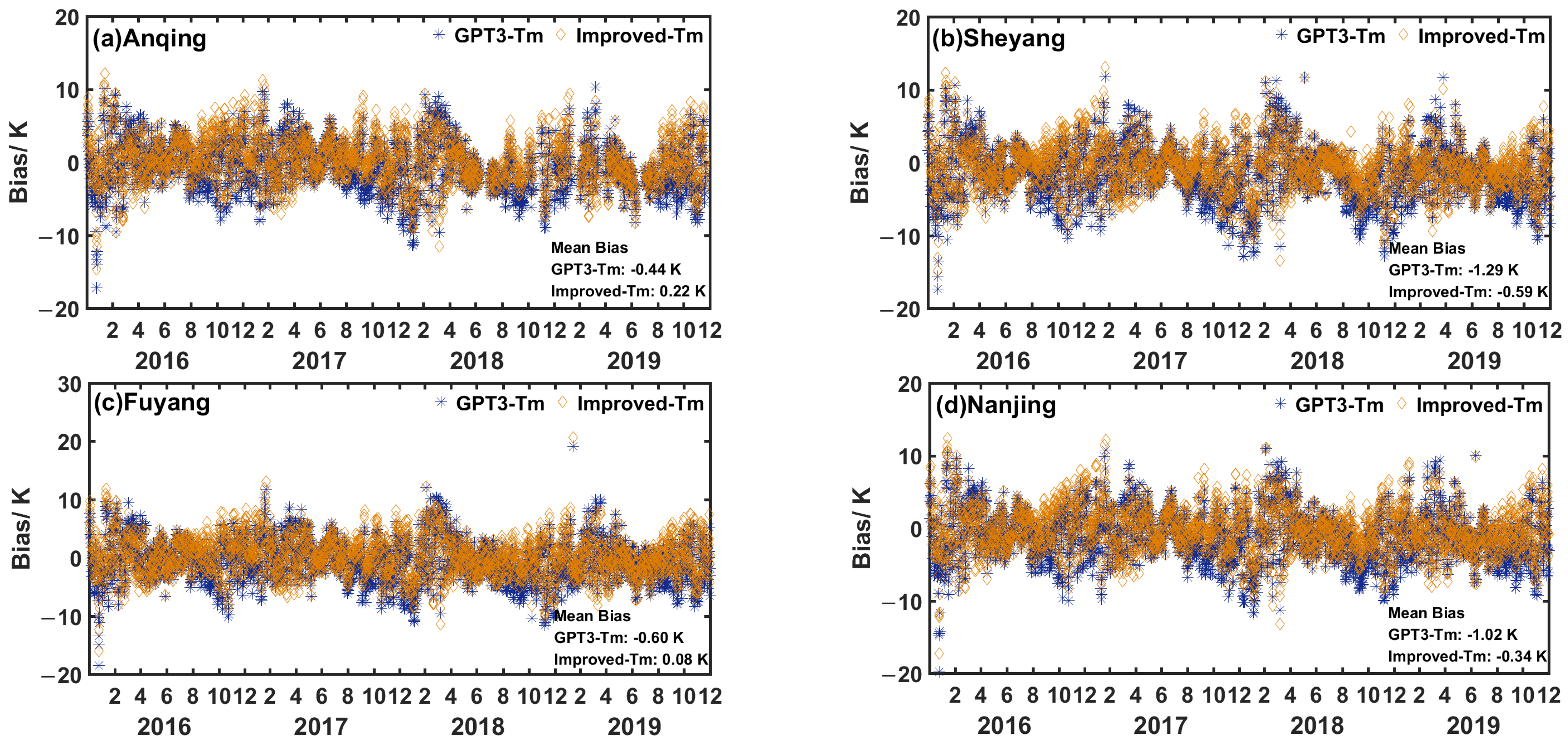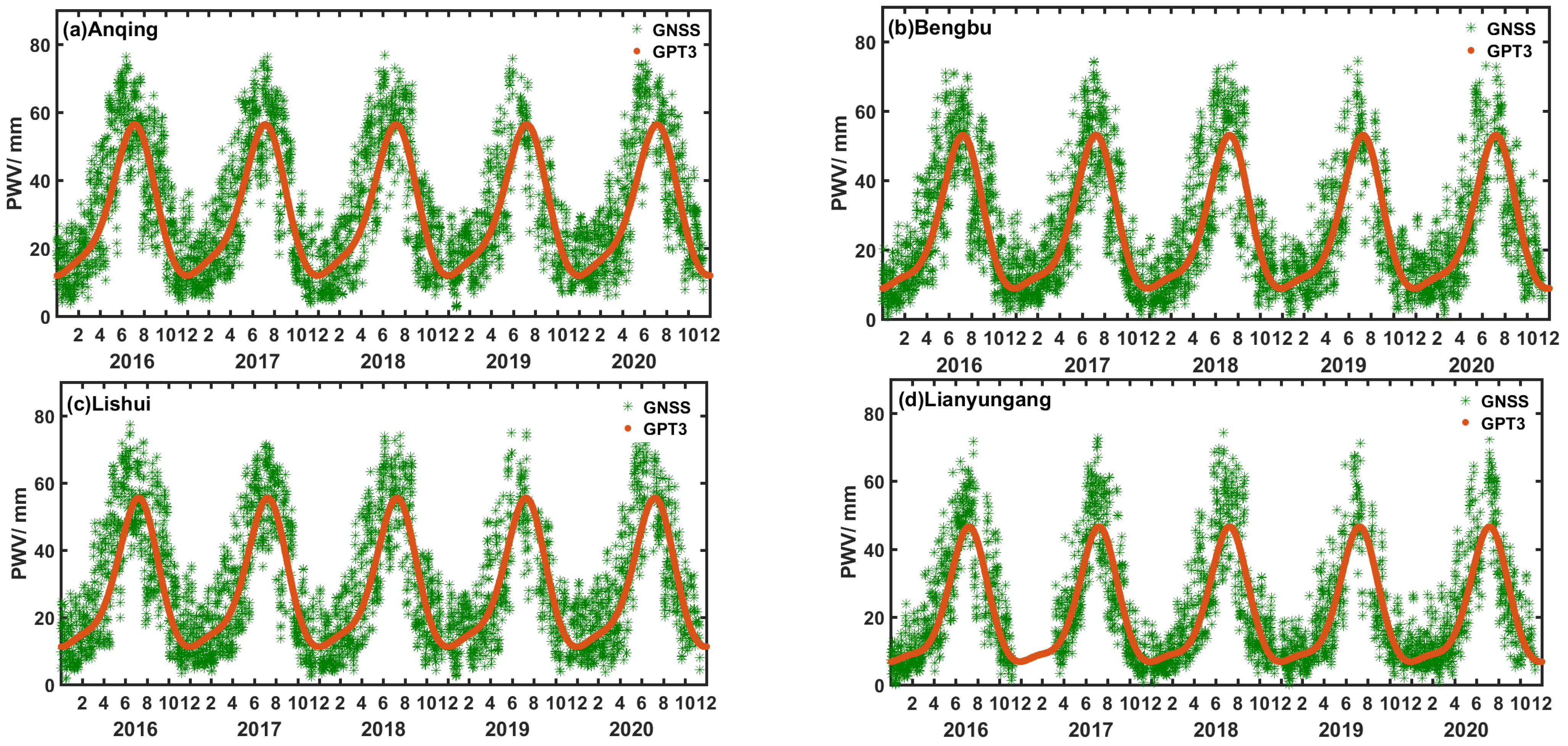The New Improved ZHD and Weighted Mean Temperature Models Based on GNSS and Radiosonde Data Using GPT3 and Fourier Function
Abstract
1. Introduction
2. Data Sources and Methodology
2.1. Data Sources
2.2. Methodology
2.2.1. Tm Calculation
2.2.2. GNSS-PWV and GPT3-PWV Calculations
2.2.3. Fourier Function
2.2.4. Statistical Method
3. Results and Discussions
3.1. The Improved ZHD Model
3.1.1. The Establishment of an Improved ZHD Model
3.1.2. Precision Analysis
3.2. The Improved Model
3.2.1. The Establishment of an Improved Model
3.2.2. Precision Analysis
3.3. The PWV Based on Improved ZHD and Models
4. Conclusions
Author Contributions
Funding
Institutional Review Board Statement
Informed Consent Statement
Data Availability Statement
Acknowledgments
Conflicts of Interest
References
- Baker, H.C.; Dodson, A.H.; Penna, N.T.; Higgins, M.; Offiler, D. Ground-based GPS water vapour estimation: Potential for meteorological forecasting. J. Atmos. Sol. Terr. Phys. 2001, 63, 1305–1314. [Google Scholar] [CrossRef]
- Iwabuchi, T.; Rocken, C.; Lukes, Z.; Mervart, L.; Johnson, J.; Kanzaki, M. PPP and Network True Real-time 30 sec Estimation of ZTD in Dense and Giant Regional GPS Network and the Application of ZTD for Nowcasting of Heavy Rainfall. In Proceedings of the ION GNSS 19th International Technical Meeting of the Satellite Division, Fort Worth, TX, USA, 26–29 September 2006; pp. 1902–1909. [Google Scholar]
- Li, L.; Kuang, C.-L.; Zhu, J.-J.; Chen, W.; Chen, Y.-Q.; Long, S.-C.; Li, H.-Y. Rainstorm nowcasting based on GPS real-time precise point positioning technology. Chin. J. Geophys. 2012, 55, 1129–1136. [Google Scholar]
- Li, H.; Wang, X.; Wu, S.; Zhang, K.; Chen, X.; Qiu, C.; Zhang, S.; Zhang, J.; Xie, M.; Li, L. Development of an Improved Model for Prediction of Short-Term Heavy Precipitation Based on GNSS-Derived PWV. Remote Sens. 2020, 12, 4101. [Google Scholar] [CrossRef]
- Bianchi, C.E.; Mendoza, L.P.O.; Fernández, L.I.; Natali, M.P.; Meza, A.M.; Moirano, J.F. Multi-year GNSS monitoring of atmospheric IWV over Central and South America for climate studies. Ann. Geophys. 2016, 34, 623–639. [Google Scholar] [CrossRef]
- Kruczyk, M. Long Series of GNSS Integrated Precipitable Water as a Climate Change Indicator. Rep. Geod. Geoinform. 2015, 99, 1–18. [Google Scholar] [CrossRef]
- Wang, B.; Zhao, L.; Bai, X. The Characteristics Investigation of Ground-Based GPS/PWV During the “7.21” Extreme Rainfall Event in Beijing. In China Satellite Navigation Conference (CSNC) 2015 Proceedings: Volume II; Sun, J., Liu, J., Fan, S., Lu, X., Eds.; Lecture Notes in Electrical Engineering; Springer: Berlin/Heidelberg, Germany, 2015; Volume 341, pp. 563–574. [Google Scholar]
- Simeonov, T.; Sidorov, D.; Teferle, F.N.; Milev, G.; Guerova, G. Evaluation of IWV from the numerical weather prediction WRF model with PPP GNSS processing for Bulgaria. Atmos. Meas. Tech. Discuss. 2016, 1–15. [Google Scholar] [CrossRef]
- Li, H.; Wang, X.; Choy, S.; Wu, S.; Jiang, C.; Zhang, J.; Qiu, C.; Li, L.; Zhang, K. A New Cumulative Anomaly-based Model for the Detection of Heavy Precipitation Using GNSS-derived Tropospheric Products. IEEE Trans. Geosci. Remote Sens. 2021, 60, 4105718. [Google Scholar] [CrossRef]
- Li, H.; Wang, X.; Choy, S.; Jiang, C.; Wu, S.; Zhang, J.; Qiu, C.; Zhou, K.; Li, L.; Fu, E.; et al. Detecting heavy rainfall using anomaly-based percentile thresholds of predictors derived from GNSS-PWV. Atmos. Res. 2022, 265, 105912. [Google Scholar] [CrossRef]
- Benevides, P.; Catalao, J.; Miranda, P.M.A. On the inclusion of GPS precipitable water vapour in the nowcasting of rainfall. Nat. Hazards Earth Syst. Sci. 2015, 15, 2605–2616. [Google Scholar] [CrossRef]
- Jiang, P.; Ye, S.; Chen, D.; Liu, Y.; Xia, P. Retrieving Precipitable Water Vapor Data Using GPS Zenith Delays and Global Reanalysis Data in China. Remote Sens. 2016, 8, 389. [Google Scholar] [CrossRef]
- Wang, H.; He, J.; Wei, M.; Zhang, Z. Synthesis Analysis of One Severe Convection Precipitation Event in Jiangsu Using Ground-Based GPS Technology. Atmosphere 2015, 6, 908–927. [Google Scholar] [CrossRef]
- Song, D.-S.; Grejner-Brzezinska, D.A. Remote sensing of atmospheric water vapor variation from GPS measurements during a severe weather event. Earth Planets Space 2009, 61, 1117–1125. [Google Scholar] [CrossRef]
- Manning, T.; Zhang, K.; Rohm, W.; Choy, S.; Hurter, F. Detecting Severe Weather using GPS Tomography: An Australian Case Study. J. Glob. Position. Syst. 2012, 11, 58–70. [Google Scholar] [CrossRef]
- Zhang, K.; Manning, T.; Wu, S.; Rohm, W.; Silcock, D.; Choy, S. Capturing the Signature of Severe Weather Events in Australia Using GPS Measurements. IEEE J. Sel. Top. Appl. Earth Obs. Remote Sens. 2015, 8, 1839–1847. [Google Scholar] [CrossRef]
- Huang, L.; Zhu, G.; Liu, L.; Chen, H.; Jiang, W. A global grid model for the correction of the vertical zenith total delay based on a sliding window algorithm. GPS Solut. 2021, 25, 98. [Google Scholar] [CrossRef]
- Huang, L.; Peng, H.; Liu, L.; Xiong, S.; Xie, S.; Chen, J.; Li, J.; He, H. GNSS Precipitable Water Vapor Retrieval with the Aid of NWM Data for China. Earth Space Sci. 2021, 8, e2020EA001550. [Google Scholar] [CrossRef]
- Wang, X.; Zhang, K.; Wu, S.; Fan, S.; Cheng, Y. Water vapor-weighted mean temperature and its impact on the determination of precipitable water vapor and its linear trend. J. Geophys. Res. Atmos. 2016, 121, 833–852. [Google Scholar] [CrossRef]
- Li, L.; Wu, S.; Zhang, K.; Wang, X.; Li, W.; Shen, Z.; Zhu, D.; He, Q.; Wan, M. A new zenith hydrostatic delay model for real-time retrievals of GNSS-PWV. Atmos. Meas. Tech. 2021, 14, 6379–6394. [Google Scholar] [CrossRef]
- Saastamoinen, J. Contributions to the theory of atmospheric refraction. Bull. Géodésique 1972, 105, 279–298. [Google Scholar] [CrossRef]
- Hopfield, H.S. Tropospheric Effect on Electromagnetically Measured Range: Prediction from Surface Weather Data. Radio Sci. 1971, 6, 357–367. [Google Scholar] [CrossRef]
- Black, H.D.; Eisner, A. Correcting satellite Doppler data for tropospheric effects. J. Geophys. Res. Atmos. 1984, 89, 2616–2626. [Google Scholar] [CrossRef]
- Leandro, R.F.; Langley, R.B.; Santos, M.C. UNB3m_pack: A neutral atmosphere delay package for radiometric space techniques. GPS Solut. 2008, 12, 65–70. [Google Scholar] [CrossRef]
- Boehm, J.; Heinkelmann, R.; Schuh, H. Short Note: A global model of pressure and temperature for geodetic applications. J. Geod. 2007, 81, 679–683. [Google Scholar] [CrossRef]
- Böhm, J.; Möller, G.; Schindelegger, M.; Pain, G.; Weber, R. Development of an improved empirical model for slant delays in the troposphere (GPT2w). GPS Solut. 2015, 19, 433–441. [Google Scholar] [CrossRef]
- Daniel, L.; Johannes, B. VMF3/GPT3: Refined discrete and empirical troposphere mapping functions. J. Geod. 2018, 92, 349–360. [Google Scholar]
- Lagler, K.; Schindelegger, M.; Böhm, J.; Krásná, H.; Nilsson, T. GPT2: Empirical slant delay model for radio space geodetic techniques. Geophys. Res. Lett. 2013, 40, 1069–1073. [Google Scholar] [CrossRef]
- Wang, X.; Zhang, K.; Wu, S.; He, C.; Cheng, Y.; Li, X. Determination of zenith hydrostatic delay and its impact on GNSS-derived integrated water vapor. Atmos. Meas. Tech. 2017, 10, 2807–2820. [Google Scholar] [CrossRef]
- Zhang, W.; Zhang, H.; Liang, H.; Lou, Y.; Cai, Y.; Cao, Y.; Zhou, Y.; Liu, W. On the suitability of ERA5 in hourly GPS precipitable water vapor retrieval over China. J. Geod. 2019, 93, 1897–1909. [Google Scholar] [CrossRef]
- Ghaffari Razin, M.-R.; Voosoghi, B. Modeling of precipitable water vapor from GPS observations using machine learning and tomography methods. Adv. Space Res. 2022, 69, 2671–2681. [Google Scholar] [CrossRef]
- Singh, D.; Ghosh, J.; Kashyap, D. Development of a site-specific ZHD model using radiosonde data. Acta Geod. Geophys. Hung. 2012, 47, 90–100. [Google Scholar] [CrossRef]
- Yang, F.; Meng, X.; Guo, J.; Shi, J.; An, X.; He, Q.; Zhou, L. The Influence of Different Modelling Factors on Global Temperature and Pressure Models and Their Performance in Different Zenith Hydrostatic Delay (ZHD) Models. Remote Sens. 2019, 12, 35. [Google Scholar] [CrossRef]
- Mateus, P.; Catalão, J.; Mendes, V.B.; Nico, G. An ERA5-Based Hourly Global Pressure and Temperature (HGPT) Model. Remote Sens. 2020, 12, 1098. [Google Scholar] [CrossRef]
- Bevis, M.; Businger, S.; Chiswell, S.; Herring, T.A.; Anthes, R.A.; Rocken, C.; Ware, R.H. GPS meteorology: Mapping zenith wet delays onto precipitable water. J. Appl. Meteorol. 1994, 33, 379–386. [Google Scholar] [CrossRef]
- Hagemann, S.; Bengtsson, L.; Gendt, G. On the determination of atmospheric water vapor from GPS measurements. J. Geophys. Res. Atmos. 2003, 108, 4678. [Google Scholar] [CrossRef]
- Huang, L.; Peng, H.; Liu, L.; Li, C.; Kang, C.; Xie, S. An empirical atmospheric weighted mean temperature model considering the lapse rate function for China. Acta Geod. Cartogr. Sin. 2020, 49, 432–442. [Google Scholar] [CrossRef]
- Bevis, M.; Businger, S.; Herring, T.A.; Rocken, C.; Anthes, R.A.; Ware, R.H. GPS meteorology: Remote sensing of atmospheric water vapor using the global positioning system. J. Geophys. Res. Atmos. 1992, 97, 15787–15801. [Google Scholar]
- Lan, Z.; Zhang, B.; Geng, Y. Establishment and analysis of global gridded Tm − Ts relationship model. Geod. Geodyn. 2016, 7, 101–102. [Google Scholar] [CrossRef]
- Mircheva, B.R. Terrestrial Water Storage Anomaly during the 2007 Heat Wave in Bulgaria. Master’s Thesis, Sofia University, Palo Alto, CA, USA, April 2016. [Google Scholar]
- Basili, P.; Bonafoni, S.; Ferrara, R.; Ciotti, P.; Fionda, E.; Arnbrosini, R. Atmospheric water vapor retrieval by means of both a GPS network and a microwave radiometer during an experimental campaign in Cagliari, Italy, in 1999. IEEE Trans. Geosci. Remote Sens. 2001, 39, 2436–2443. [Google Scholar] [CrossRef]
- Jiang, P.; Ye, S.R.; Liu, Y.Y.; Zhang, J.J.; Xia, P.F. Near real-time water vapor tomography using ground-based GPS and meteorological data: Long-term experiment in Hong Kong. Ann. Geophys. 2014, 32, 911–923. [Google Scholar] [CrossRef]
- Song, D.-S.; Boutiouta, S. Determination of Algerian Weighted Mean Temperature Model for forthcoming GNSS Meteorology Application in Algeria. J. Korean Soc. Surv. Geod. Photogramm. Cartogr. 2012, 30, 615–622. [Google Scholar] [CrossRef]
- Isioye, O.A.; Combrinck, L.; Botai, J. Modelling weighted mean temperature in the West African region: Implications for GNSS meteorology. Meteorol. Appl. 2016, 23, 614–632. [Google Scholar] [CrossRef]
- Liu, Y.; Chen, Y.; Liu, J. Determination of weighted mean tropospheric temperature using ground meteorological measurements. Geo-Spat. Inf. Sci. 2001, 4, 14–18. [Google Scholar] [CrossRef]
- Singh, D.; Ghosh, J.K.; Kashyap, D. Weighted mean temperature model for extra tropical region of India. J. Atmos. Sol.-Terr. Phys. 2014, 107, 48–53. [Google Scholar] [CrossRef]
- Elhaty, N.M.; Abdelfatah, M.A.; Mousa, A.E.; El-Fiky, G.S. GNSS meteorology in Egypt: Modeling weighted mean temperature from radiosonde data. Alex. Eng. J. 2019, 58, 443–450. [Google Scholar] [CrossRef]
- Li, J.; Mao, J. The approach to remote sensing of water vapor based on GPS and linear regression Tm in eastern region of China. J. Meteorol. Res. 1998, 12, 450–458. [Google Scholar]
- Yu, S.; Liu, L. Validation and Analysis of the Water-Vapor-Weighted Mean Temperature from Tm-Ts Relationship. Geomat. Inf. Sci. Wuhan Univ. 2009, 34, 741–744. [Google Scholar]
- Wang, Y.; Liu, L.; Hao, X.; Xiao, J.; Wang, H.; Xu, H. The application study of the GPS meteorology network in Wuhan region. Acta Geod. Cartogr. Sin. 2007, 36, 142–145. [Google Scholar]
- Guo, B.; Li, L.; Xie, W. Modelling of weighted mean temperature using radiosonde data in Yangtze River Delta region. J. Navig. Position. 2019, 7, 61–67. [Google Scholar]
- Gong, S. The Spatial and Temporal Variations of Weighted Mean Atmospheric Temperature and Its Models in China. J. Appl. Meteorol. Sci. 2013, 24, 332–334. [Google Scholar]
- Wang, X.; Song, L.; Dai, Z.; Cao, Y. Feature analysis of weighted mean temperature Tm in Hong Kong. J. Nanjing Univ. Inf. Sci. 2011, 3, 47–52. [Google Scholar]
- Yao, Y.; Zhang, B.; Xu, C.; Yan, F. Improved one/multi-parameter models that consider seasonal and geographic variations for estimating weighted mean temperature in ground-based GPS meteorology. J. Geod. 2013, 88, 273–282. [Google Scholar] [CrossRef]
- Yao, Y.; Liu, J.; Zhang, B.; He, C. Nonlinear Relationships Between the Surface Temperature and the Weighted Mean Temperature. Geomat. Inf. Sci. Wuhan Univ. 2015, 40, 112–116. [Google Scholar]
- Zhu, H.; Chen, K.; Huang, G. A Weighted Mean Temperature Model with Nonlinear Elevation Correction Using China as an Example. Remote Sens. 2021, 13, 3887. [Google Scholar] [CrossRef]
- Ma, Y.; Chen, P.; Liu, T.; Xu, G.; Lu, Z. Development and Assessment of an ALLSSA-Based Atmospheric Weighted Mean Temperature Model with High Time Resolution for GNSS Precipitable Water Retrieval. Earth Space Sci. 2022, 9, e2021EA002089. [Google Scholar] [CrossRef]
- Feng, P.; Li, F.; Yan, J.; Zhang, F.; JeanPierre, B. Assessment of the Accuracy of the Saastamoinen Model and VMF1/VMF3 Mapping Functions with Respect to Ray-Tracing from Radiosonde Data in the Framework of GNSS Meteorology. Remote Sens. 2020, 12, 3337. [Google Scholar] [CrossRef]
- Yang, F.; Guo, J.; Zhang, C.; Li, Y.; Li, J. A Regional Zenith Tropospheric Delay (ZTD) Model Based on GPT3 and ANN. Remote Sens. 2021, 13, 838. [Google Scholar] [CrossRef]
- Ding, J.; Chen, J. Assessment of Empirical Troposphere Model GPT3 Based on NGL’s Global Troposphere Products. Sensors 2020, 20, 3631. [Google Scholar] [CrossRef]
- Li, S.; Xu, T.; Xu, Y.; Jiang, N.; Bastos, L. Forecasting GNSS Zenith Troposphere Delay by Improving GPT3 Model with Machine Learning in Antarctica. Atmosphere 2022, 13, 78. [Google Scholar] [CrossRef]
- Yu, J.; Tan, K.; Zhang, C.; Zhao, B.; Wang, D.; Li, Q. Present-day crustal movement of the Chinese mainland based on Global Navigation Satellite System data from 1998 to 2018. Adv. Space Res. 2019, 63, 840–856. [Google Scholar] [CrossRef]
- Li, L.; Yuan, L.; Qimin, H.; Xiaoming, W. Weighted Mean Temperature Modelling Using Regional Radiosonde Observations for the Yangtze River Delta Region in China. Remote Sens. 2022, 14, 1909. [Google Scholar] [CrossRef]
- Wang, K.; Khodabandeh, A.; Teunissen, P.J.G. MSE-impact of PPP-RTK ZTD estimation strategies. Adv. Space Res. 2018, 61, 2955–2971. [Google Scholar] [CrossRef]
- Salcedo, A.C.; Recio, J.B. Fourier analysis of meteorological data to obtain a typical annual time function. Sol. Energy 1984, 32, 479–488. [Google Scholar] [CrossRef]
- Askne, J.; Nordius, H. Estimation of tropospheric delay for microwaves from surface weather data. Radio Sci. 1987, 22, 379–386. [Google Scholar] [CrossRef]













| Parameter | ||||||||
|---|---|---|---|---|---|---|---|---|
| ZHD | −0.3909 | −0.2525 | −2.676 | −0.2953 | 0.3294 | 0.00059 | −0.0097 | 0.01718 |
| Sites | GPT3-ZHD | Improved-ZHD | ||||||
|---|---|---|---|---|---|---|---|---|
| 2016–2018 | 2019–2020 | 2016–2018 | 2019–2020 | |||||
| Bias | RMS | Bias | RMS | Bias | RMS | Bias | RMS | |
| Anqing | −0.1 | 2.0 | −0.2 | 2.1 | 0.3 | 0.4 | 0.4 | 0.4 |
| Bengbu | 0.1 | 2.2 | −0.0 | 2.2 | 0.6 | 0.7 | 0.6 | 0.7 |
| Jiande | −0.8 | 2.0 | −1.0 | 1.8 | −0.4 | 0.5 | −0.4 | 0.7 |
| Lishui | −0.2 | 2.1 | −0.4 | 2.1 | 0.2 | 0.4 | 0.2 | 0.4 |
| Lianyungang | −0.7 | 2.2 | −1.0 | 2.3 | −0.4 | 0.4 | −0.4 | 0.4 |
| Shanghai | −0.4 | 1.9 | −2.2 | 2.3 | 0.0 | 0.4 | −0.4 | 0.4 |
| Wenzhou | −0.9 | 1.9 | −1.0 | 2.0 | −0.5 | 0.8 | −0.4 | 0.5 |
| Average | −0.4 | 2.0 | −0.8 | 2.1 | −0.0 | 0.5 | −0.1 | 0.5 |
| Parameter | ||||||||
|---|---|---|---|---|---|---|---|---|
| −0.8249 | −1.247 | 1.301 | −0.2511 | −0.2311 | 0.2893 | −0.9035 | 0.01729 |
| Sites | ||||||||
|---|---|---|---|---|---|---|---|---|
| 2016–2018 | 2019 | 2016–2018 | 2019 | |||||
| Bias | RMS | Bias | RMS | Bias | RMS | Bias | RMS | |
| Anqing | −0.2 | 3.0 | −1.1 | 2.9 | 0.4 | 2.8 | −0.3 | 2.7 |
| Sheyang | −1.1 | 3.4 | −1.7 | 3.3 | −0.5 | 2.8 | −0.9 | 2.7 |
| Fuyang | −0.5 | 3.2 | −1.0 | 2.9 | 0.2 | 2.9 | −0.3 | 2.7 |
| Nanjing | −0.8 | 3.2 | −1.5 | 3.1 | −0.2 | 2.8 | −0.7 | 2.6 |
| Hangzhou | −1.0 | 3.4 | −1.8 | 3.4 | −0.3 | 2.8 | −1.0 | 2.8 |
| Quzhou | 0.1 | 3.0 | −0.9 | 2.7 | 0.7 | 2.9 | −0.2 | 2.5 |
| Shanghai | −1.9 | 3.4 | −1.9 | 3.4 | −0.4 | 2.8 | −1.1 | 2.6 |
| Average | −0.8 | 3.2 | −1.4 | 3.1 | −0.0 | 2.8 | −0.6 | 2.7 |
| Sites | GPT3-PWV | Improved-PWV | ||
|---|---|---|---|---|
| Bias | RMS | Bias | RMS | |
| Anqing | 2.9 | 11.3 | 0.6 | 0.6 |
| Bengbu | 1.3 | 10.2 | 0.5 | 0.6 |
| Jiande | 3.3 | 11.4 | 0.4 | 0.4 |
| Lishui | 1.8 | 11.2 | 0.5 | 0.5 |
| Lianyungang | 1.6 | 9.2 | 0.4 | 0.4 |
| Shanghai | 5.2 | 13.3 | 0.7 | 0.8 |
| Wenzhou | 3.0 | 11.0 | 0.7 | 0.7 |
| Average | 2.7 | 11.1 | 0.5 | 0.6 |
| Sites | Improved-PWV | GNSS-PWV | ||
|---|---|---|---|---|
| Bias | RMS | Bias | RMS | |
| Anqing | −1.2 | 3.9 | −1.8 | 4.2 |
| Shanghai | −1.0 | 3.4 | −1.5 | 3.7 |
| Average | −1.1 | 3.7 | −1.6 | 4.0 |
Publisher’s Note: MDPI stays neutral with regard to jurisdictional claims in published maps and institutional affiliations. |
© 2022 by the authors. Licensee MDPI, Basel, Switzerland. This article is an open access article distributed under the terms and conditions of the Creative Commons Attribution (CC BY) license (https://creativecommons.org/licenses/by/4.0/).
Share and Cite
Li, L.; Gao, Y.; Xu, S.; Lu, H.; He, Q.; Yu, H. The New Improved ZHD and Weighted Mean Temperature Models Based on GNSS and Radiosonde Data Using GPT3 and Fourier Function. Atmosphere 2022, 13, 1648. https://doi.org/10.3390/atmos13101648
Li L, Gao Y, Xu S, Lu H, He Q, Yu H. The New Improved ZHD and Weighted Mean Temperature Models Based on GNSS and Radiosonde Data Using GPT3 and Fourier Function. Atmosphere. 2022; 13(10):1648. https://doi.org/10.3390/atmos13101648
Chicago/Turabian StyleLi, Li, Ying Gao, Siyi Xu, Houxian Lu, Qimin He, and Hang Yu. 2022. "The New Improved ZHD and Weighted Mean Temperature Models Based on GNSS and Radiosonde Data Using GPT3 and Fourier Function" Atmosphere 13, no. 10: 1648. https://doi.org/10.3390/atmos13101648
APA StyleLi, L., Gao, Y., Xu, S., Lu, H., He, Q., & Yu, H. (2022). The New Improved ZHD and Weighted Mean Temperature Models Based on GNSS and Radiosonde Data Using GPT3 and Fourier Function. Atmosphere, 13(10), 1648. https://doi.org/10.3390/atmos13101648









